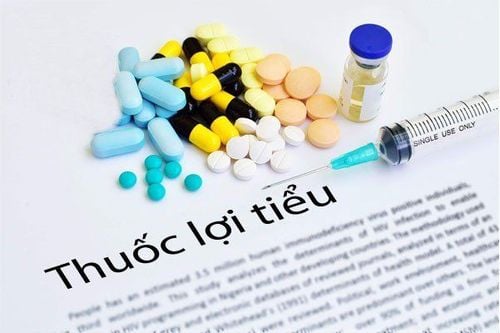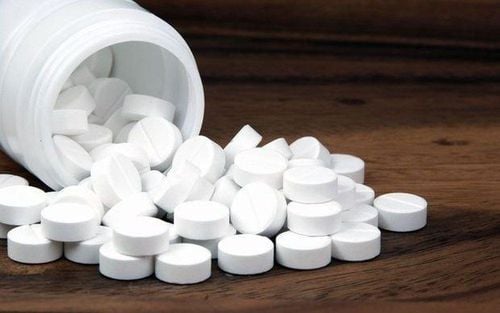This is an automatically translated article.
Diuretics are a group of drugs that help remove excess salt and water from your body by increasing urine excretion, thereby reducing the burden on the circulatory system. This has important implications in the treatment of heart failure and a number of other diseases such as hypertension, edema, liver and kidney disease, glaucoma.... The following article will provide the reasons why it is used. diuretics in the treatment of chronic heart failure.
1. Why use diuretics in the treatment of chronic heart failure?
Heart failure (HF) is a syndrome defined as the failure of the heart to deliver oxygen at a rate corresponding to that required by the metabolic tissues, even when the filling pressure is normal (or only due to the increased fullness), secondary to abnormalities of cardiac structure or function.
HF is the most common cause of hospitalization in patients over 65 years of age. The main manifestations of the syndrome are symptoms due to vascular obstruction, such as dyspnea, abdominal distention, edema formation, and symptoms due to low systemic perfusion.
One of the main therapies is aimed at increasing blood volume through the use of diuretics. The therapeutic effects of diuretics have been known for centuries, and they are probably the first line of treatment for chronic heart failure. As early as the 1600s, liquid diuretics were used to treat edema, or ascites. The 20th century saw the introduction of carbonic anhydrase inhibitors, followed by thiazide diuretics, and finally loop diuretics. Today, diuretics remain some of the most commonly prescribed medications worldwide. Diuretics have been shown to be an integral component of the treatment of acute and chronic heart failure, and their use has been extensively studied. Their effectiveness in improving symptoms such as dyspnea and edema is evident; however, little data support a benefit in mortality or change in disease progression.
For many years, diuretics have been the cornerstone of the treatment of both acute and chronic heart failure. Guidelines for the use of diuretics in both inpatient and outpatient settings are largely based on expert opinion. Diuretics clearly improve hemodynamics and symptoms, although many studies have failed to demonstrate a mortality benefit. In part, their effectiveness may be limited by side effects including electrolyte imbalance and neuronal activation.
2. Mechanism of diuretics in the treatment of heart failure
Knowledge of pharmacology is required to understand the function of diuretics in the treatment of heart failure. The currently available loop diuretics are furosemide, torsemide, bumetanide, and ethacrynic acid. They inhibit the Na-K-2Cl co-transporter in the thick ascending limb of the loop of Henle. By effectively inhibiting sodium reabsorption, they also reduce water reabsorption. Loop diuretics bind to the light surface of the transporter; therefore, they must be secreted into the lumen. As glomerular filtration rate decreases, mucus secretion decreases, and less drug reaches the site of action.
The effectiveness of diuretics in improving symptoms of heart failure such as dyspnea and edema has long been documented. However, the use of diuretics in patients with heart failure carries certain risks. Various electrolyte abnormalities may occur. Inhibition of the Na-K-2Cl channel leads to increased distribution of sodium to the distal convoluted tubules and cortical collecting ducts. Through the ENaC (anti-Na-K) channel, distal sodium is reabsorbed at the expense of potassium loss, resulting in hypokalemia. Hypomagnesemia can occur as well, causing hypokalemia. This imbalance can contribute to arrhythmias.
Loss of chloride can lead to hypochloremic metabolic alkalosis. Significant alkalosis can depress the airways in patients with respiratory failure. Hyponatremia can also occur with diuretics, more commonly with thiazides than with loop diuretics, and especially if large amounts of water are taken. Although hyponatremia itself is rarely symptomatic, its presence is an indication of a poor prognosis.

Thuốc lợi tiểu điều trị suy tim có cơ chế hoạt động riêng
3. Diuretics used to treat chronic heart failure
3.1 Loop diuretics Loop diuretics inhibit the Na + ⁄2Cl-⁄K + co-transporter of the thick ascending loop of Henle, where one-third of the filtered sodium is reabsorbed. This reduces sodium and chloride reabsorption and increases diuresis.Loop diuretics also enhance the synthesis of prostaglandins, which relax the kidneys and veins. This explains some of the cardiac effects, such as a decrease in pulmonary wedge pressure. However, it is important to recognize that the diuretic effect of loop diuretics may be reduced when used concomitantly with nonsteroidal anti-inflammatory drugs (NSAIDs), possibly because they inhibit prostaglandin synthesis in the gastrointestinal tract. kidney. Loop diuretics include furosemide, bumetanide, torsemide, and ethacrynic acid. Furosemide is often preferred in the presence of chronic heart failure because of its rapid sodium loss, which is effective even in the presence of low glomerular filtration rate and varicose veins. In patients with chronic heart failure, the absorption of loop diuretics is often delayed and maximal effect occurs only after 4 hours. In addition, the renal response to loop diuretics is also reduced, affecting sodium excretion in patients with grade II and III heart failure to only 1/3-1/4 and even lower with heart failure. heavier level. In order to increase the response to this drug, it is not necessary to use very high doses (except in cases of concomitant renal failure) but should increase the number of times a day with a moderate dose.
Bioavailability and half-life of the drug are also clinically important. For oral furosemide, the normal extent of absorption is 50% but can vary from 10-100%, making it difficult to assess efficacy, whereas bumetanide and furosemide are absorbed almost completely. 80-100%, many researchers believe that patients with heart failure are better treated with this loop diuretic than with furosemide.
The number of times per day also depends on the half-life of each drug. While thiazides can be administered 1-2 times a day due to their long half-life, loop diuretics have a short half-life (bumetanide 1 hour, torsemide 3-4 hours, furosemide 1-2 hours) so they have beneficial effects. Diuresis usually decreases before the next dose is administered and during that time the renal tubules actively reabsorb sodium. Therefore, the patient still has to take loop diuretics several times a day. In addition, the patient should also lie down for 1-2 hours after taking the drug to have a better diuretic effect.
If the patient has concomitant renal failure, the dose of furosemide should be higher. Sodium clearance is maximal with bolus doses of 160-200 mg furosemide, with no benefit seen with larger doses. In some patients the above bolus dose may be repeated several times a day.
Using the appropriate diuretic dose is the decisive factor for the success of treatment and the effectiveness of drugs in combination with diuretics such as ACE inhibitors, vasodilators. Diuretics at too low a dose will cause fluid retention, reduce the effectiveness of ACE inhibitors, and increase the risk of beta-blockers. Excessively high doses of diuretics cause volume depletion and increase the risk of hypotension when used with ACE inhibitors and vasodilators.
Electrolyte disturbances occurring during diuretic therapy should be managed aggressively while diuresis should be maintained if the patient is still waterlogged. If blood pressure is slightly reduced and blood urea is elevated due to diuretic use, but no symptoms, the diuretic is still maintained. It is important to accurately assess whether the drop in blood pressure and the rise in blood urea nitrogen is due to excessive diuretic use or to worsening heart failure. If the patient has no symptoms of fluid retention, this may be due to volume depletion, the diuretic dose should be reduced when changes in blood pressure and renal function are evident and causing symptoms. With water retention, it is possible that blood pressure decreases and blood urea is increased due to worsening heart failure, need to maintain diuretic dose and increase renal perfusion with vasopressors or vasodilators.
Furosemide is by far the most common oral loop diuretic, but patients who are resistant to oral furosemide therapy may benefit from trials with second-generation oral loop diuretics (bumetanide and torsemide). . These agents may be more effective, due to increased potency and oral bioavailability.
3.2 Thiazide diuretics and metolazone Benzothiazide diuretics inhibit the sodium-chloride transporter in the distal ascending limb and the distal convoluted tubule. They prevent maximal dilution of urine, thereby increasing free water clearance and excretion of sodium and chloride across the renal tubular epithelium. High sodium delivery to the collecting ducts enhances the exchange of sodium for potassium and, as a result, depletes potassium.
They are less effective in patients with reduced glomerular filtration rate, because they exert a diuretic effect from the outside of the nephron. Although they are less potent than loop diuretics, they can act synergistically with them when sequential fractional nephron blockade is achieved. Thiazides are the first choice diuretics by doctors for mild heart failure and chronic heart failure. Start with a low dose, gradually increasing it with worsening heart failure before switching to loop diuretics or combining them with loop diuretics. The effectiveness of thiazides is usually less when renal function declines, 25 - 50 mg of hydrochloro-thiazide can be used. The current trend is that physicians will use ACE inhibitors in combination with ACE inhibitors whenever diuretics are used (unless contraindicated) because ACE inhibitors will inhibit activation of the renin-angiotensin system. caused by diuretic use. In addition, ACE inhibitors also have an indirect diuretic effect by inhibiting aldosterone and are considered a form of potassium-sparing diuretic. If the patient does not tolerate ACE inhibitors during treatment (persistent dry cough), an angiotensin II AT1 receptor blocker should be substituted. AT1 inhibitors should also be selected for patients with diabetes, especially when the patient begins to show signs of renal failure. To make the diuretic effect easier, it is recommended that the patient lie down for 1-2 hours after taking the drug.
Metolazone is not a thiazide but works in a similar way. Metolazone is more potent than hydrochlorothiazide and remains effective even with severe reductions in glomerular filtration rate (GFR). The standard dose is 5 - 20 mg once daily, effective 24 hours. If combined with furosemide can cause diuresis very quickly and massively.

Lợi tiểu trong suy tim dùng thuốc thiazide và metolazone
3.4 Potassium supplementation with diuretics The concern about hypokalemia with possible complications such as extrasystoles and digoxin toxicity leads to routine potassium supplementation during diuretic therapy, especially with furosemide. high dose intravenous injection. In fact, the amount of potassium lost in the urine with furosemide (10 mM/l) is relatively low (compared to 25 mM/l with thiazides) and the short action of furosemide allows the body to rebalance potassium and magnesium after the action. Diuretic. Furthermore, high-dose furosemide is used only in the presence of severe renal or cardiac failure with impaired renal potassium excretion, so routine potassium supplementation is only required at low doses. If loop diuretics are used in combination with a potassium-sparing diuretic such as spironolactone, there is no need to add potassium but only periodic monitoring of serum potassium. It should be noted that hyperkalemia is more common when diuretics are combined with ACE inhibitors.
4. The phenomenon of diuretic resistance
Resistance to diuretics is a common problem in patients with heart failure. Removal of excessive fluid is usually achieved by a combination of salt restriction and loop diuretics, but in some cases, obstruction persists despite adequate diuretic therapy. This has been called diuretic resistance. The prevalence of diuretic resistance in the heart failure population is unknown due to the heterogeneity of the populations studied, the prevalence of frequent comorbidities, different treatment regimens, as well as definitions. used in different clinical trials. In a retrospective analysis of 1,153 patients with advanced heart failure, 402 patients developed diuretic resistance (defined in this study as requiring furosemide > 80 mg or bumetanide > 2 mg daily). Diuretic resistance was independently associated with total mortality, sudden death, and death from pump failure. Loop diuretics are 'threshold drugs'. Heart failure shifts the dose-response curve for loop diuretics downward and to the right. Therefore, a higher starting dose of a loop diuretic is required to achieve a similar level of sodium excretion.
There are two types of diuretic tolerance:
Short-term tolerance is a decrease in response to a diuretic after the first dose. The mechanism is unknown, possibly due to activation of angiotensin II or the sympathetic nervous system. Long-term drug tolerance is that with prolonged use of loop diuretics, fluid escapes from the loop of Henle into the distal tubule and causes distal tubule hypertrophy (mechanism unknown) and increased sodium absorption. Thus, sodium released from the loop of Henle is reabsorbed in the distal tubule. Thiazides block the renal tubules right at the point of hypertrophy, so there is a synergistic effect when combined with loop diuretics. * The phenomenon of diuretic resistance can be overcome by:
Using intravenous diuretics, combining 2 diuretics (furosemide and thiazide), using diuretics in combination with inotropic drugs. Low doses of dopamine < 3 mcg/kg/min given intermittently may improve renal hemodynamics and increase responsiveness to loop diuretics. However, a study by Vargo et al. (1996) concluded that in patients with heart failure, dopamine did not add to the response to the maximal effective dose of furosemide. Loop Diuretic Acetazolamide: Acetazolamide (diamox), a carbonic anhydrase inhibitor, is a weak diuretic, but has been used in patients with congestive heart failure unresponsive to high-dose loop diuretics and in patients with metabolic alkalosis. In these patients, sodium reabsorption is increased in the proximal tubule, reducing sodium to the loop and distal tubule, causing a loss of loop diuretic efficacy. However, acetazolamide should only be used if thiazides have been used and loop diuretics have not been effective. The dose of acetazolamide 500 mg intravenous can be combined with furosemide continuous infusion. No studies have been performed to evaluate the efficacy of acetazolamide in patients with severe heart failure. Continuous intravenous infusion of furosemide with an electric pump at a dose of 1 to 2 mg/kg/24 h can resolve the refractory state to the aforementioned diuretics in patients with severe heart failure, low ejection fraction and severe blood stasis.

Thuốc lợi tiểu điều trị suy tim có thể được dùng qua đường tiêm tĩnh mạch
5. Notes when using diuretics for patients with chronic heart failure
Before being prescribed a diuretic, you need to talk to your doctor about all the medications you are taking. Because many drugs can interfere with the effect of diuretics or increase unwanted side effects.
When taking medicine, it is necessary to strictly follow the instructions of the doctor. If you are taking a single dose during the day, it should be taken in the morning rather than in the evening, to avoid disrupting your sleep by waking up to urinate more than once.
If you are taking hypokalemic diuretics (thiazide group, loop diuretic), you need to increase your intake of potassium-rich foods such as bananas, oranges, or cruciferous vegetables such as spinach, cauliflower , cabbage, ... or take potassium supplements as directed by your doctor. On the contrary, if you use potassium-sparing diuretics, you need to limit those foods in your daily meal.
Potassium-sparing diuretics can cause calcium deficiency in the body, so you need to pay attention to calcium supplements in your diet with foods such as milk, shrimp, crab, cheese... when using this group of drugs. this.
Cardiovascular Center - Vinmec Times City International General Hospital is one of the leading centers of Vinmec Times City International General Hospital, the heart center's experts include Professors, Doctor, Doctor of Specialist 2, Master of experience, has great reputation in the field of medical treatment, surgery, interventional cardiac catheterization and application of advanced techniques in the diagnosis and treatment of diseases. cardiovascular theory.
In particular, the Center has modern equipment, on par with the most prestigious hospitals in the world, including the Hybrid operating room equipped with advanced equipment such as DSA angiography machine, induction machine. Anesthesiology integrates the most closely integrated patient hemodynamic monitoring software (PiCCO system, entropy,...).
Please dial HOTLINE for more information or register for an appointment HERE. Download MyVinmec app to make appointments faster and to manage your bookings easily.
Reference sources: emedicine.medscape.com , ecrjournal.com












